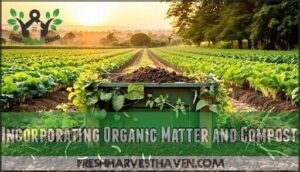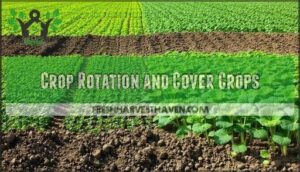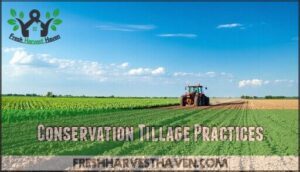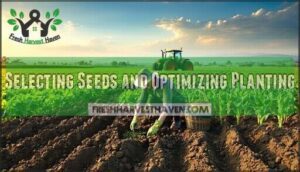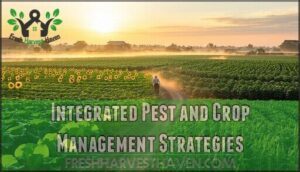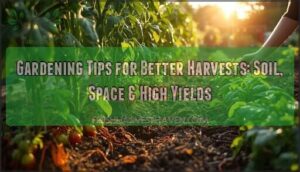This site is supported by our readers. We may earn a commission, at no cost to you, if you purchase through links.

The difference between average and outstanding harvests often comes down to understanding what your soil needs, when your crops need it, and how to deliver both with surgical precision. Maximizing crop yield techniques isn’t about working harder; it’s about working with better information, proven methods, and a clear-eyed view of what actually moves the needle on your operation.
Table Of Contents
Key Takeaways
- Precision irrigation combined with balanced nutrient management can boost yields by 20-30% without expanding acreage, making data-driven resource delivery more effective than simply increasing inputs.
- Soil health improvements through organic matter, crop rotation, cover crops, and conservation tillage create the foundation for sustainable yield increases while reducing erosion and improving water retention.
- Integrated pest management strategies that combine biological controls with targeted chemical applications reduce pest populations by 63% while preserving beneficial insects, unlike chemical-only approaches that harm pollinators and accelerate resistance.
- Variable-rate fertilizer application based on soil mapping can cut nitrogen costs by 15% while increasing yields by 22%, demonstrating that targeted nutrient delivery outperforms blanket fertilization.
Why Maximizing Crop Yield is Essential
Boosting crop yields isn’t just about growing more—it’s about securing food production’s long-term prospects while protecting the land we depend on. Higher yields mean better incomes for farmers, less pressure to clear forests, and reliable food supplies for communities worldwide.
Maximizing crop yields secures food for growing populations while protecting farmland, forests, and farmer livelihoods
Let’s look at why maximizing crop yield matters now more than ever.
Meeting Global Food Demand
Necessity spurs creativity when you’re facing rising Demand Projections and the reality of Yield Plateaus. To meet global food demand, you need to focus on:
- Boosting Yields through sustainable agriculture
- Prioritizing Food Security for vulnerable regions
- Investing in Climate Adaptation to protect crops
Increasing crop yields is essential for securing food for nearly 9.7 billion people. Employing techniques like integrated pest management can further crop production.
Enhancing Farmer Profitability and Livelihoods
When crop yields rise, you’re not just growing more—you’re improving livelihoods. Sustainable agriculture, better soil health, and nutrient management cut input costs and boost profits.
Reliable irrigation and smart risk management help you weather tough seasons.
With fair pricing, market access, and policy support, farmers gain stability, making their communities more resilient and future-ready.
Reducing Environmental Impact
When you boost yields with sustainable farming practices, you’re protecting more than your bottom line. Smart techniques—like Carbon Sequestration, Water Conservation, and Biodiversity Support—help minimize waste and slash greenhouse gas emissions.
Improving soil health and using precision irrigation means less land cleared, fewer resources wasted, and a measurable reduction in environmental impact, all while keeping your fields productive. Farmers can improve their yields by using precision irrigation systems, which can increase crop yields by up to 20%.
Supporting Food Security and Rural Communities
When you invest in sustainable agriculture training and focus on soil health, you’re not just raising crop yields—you’re strengthening rural economic growth and food security.
Sustainable farming builds community resilience by supporting local food systems and promoting food access equity.
For rural communities, these efforts lay the groundwork for reliable harvests and a healthier, more secure future for everyone involved.
Improving Soil Health for Better Yields
Healthy soil is the foundation for strong crops and higher yields. There are several proven ways you can improve soil quality on your farm.
Here are a few practical techniques to think about.
Incorporating Organic Matter and Compost
Often, it comes down to how much organic matter you’re adding to the soil. Composting methods—like vermicomposting—give you rich soil amendments that boost fertility and carbon sequestration. Compost tea delivers nutrients directly to plant roots.
When you invest in compost and organic matter, you’re setting the stage for better soil health and higher crop yields, year after year.
Crop Rotation and Cover Crops
When you weave crop rotation and cover crops into your routine, you’re building rotation yield stability and boosting soil organic matter. These practices disrupt pest cycles and improve nutrient efficiency, letting you cut back on synthetic inputs.
Cover crop benefits go beyond weed suppression—they improve soil health and drive sustainable farming, setting the foundation for resilient, higher crop yields.
Conservation Tillage Practices
With conservation tillage, you’re giving your soil a chance to breathe and rebuild, setting the stage for healthier crops season after season. By minimizing soil disturbance, you boost erosion reduction and water retention, lock in carbon for better sequestration, and save fuel.
These sustainable farming practices improve soil health but also drive higher crop yields through effective erosion control.
Selecting Seeds and Optimizing Planting
Selecting the right seeds and planning your planting approach can make a big difference in your harvest. It’s about matching what you grow to your land and local conditions.
Here’s what you need to think about before you get started.
Choosing High-Yield, Disease-Resistant Varieties
Imagine boosting your crop yields while sidestepping major disease threats. You can achieve this by prioritizing seed selection with proven Genetic Potential and Resistance Durability.
Varietal Adoption of hybrid seeds developed through Molecular Breeding reduces disease incidence and pest resistance issues.
Smart Seed Economics means every dollar spent on improved varieties delivers better returns and fewer headaches come harvest.
Matching Seeds to Local Climate Conditions
Picking the right seeds for your climate is like choosing the perfect shoes for a long hike—get it wrong and you’ll struggle, but the right fit makes all the difference. Climate-Resilient Varieties sourced from Regional Seed Banks, paired with Adaptive Breeding, guarantee your seed selection matches local climate conditions.
Microclimate Considerations and Localized Seed Trials boost climate adaptability and resilience.
Consulting Local Experts and Experimenting With New Varieties
Local Knowledge and Expert Recommendations can guide your seed selection, ensuring you pick varieties with strong germination rates and climate adaptability.
By running Variety Trials—small-scale experiments with Seed Innovation—you’ll see firsthand how different seeds perform under your local climate conditions.
Adaptive Farming means staying curious, testing, and weaving new options into your rotation for resilient, profitable yields.
Advanced Water and Nutrient Management Techniques
Managing water and nutrients well is key if you want to push your yields higher and keep your soil healthy. There are proven techniques that help you use resources wisely and get the most from every acre.
Here’s what you should know about the top approaches.
Precision Irrigation Systems and Scheduling
A reliable way to boost water use efficiency and yield increase impact is through precision irrigation systems. Drip irrigation, for example, can cut water consumption by up to 50% and drive 20–30% higher yields.
By integrating sophisticated technologies and smart scheduling, you’ll see economic input savings, improved water management, and greater environmental sustainability—all essential for your farm’s future.
Using Soil Moisture Sensors for Efficiency
Sensor placement is key—positioning soil moisture sensors at root depth ensures accurate readings. With proper sensor calibration, you’ll avoid misinterpretation and make data-driven irrigation decisions.
Irrigation automation, guided by real-time data interpretation, streamlines water management. Precision irrigation powered by sensors delivers water only when necessary, saving costs and promoting water conservation.
Consider cost analysis before scaling up.
Balanced Fertilizer Application
Balanced fertilizer application hinges on accurate soil testing analysis—think of it as reading your field’s nutrient map before you act. By matching fertilizers to your crop’s needs and using precise fertilizer timing methods, you boost nutrient use efficiency and crop yields.
Sustainable fertilizer practices also cut environmental impact, helping you maintain soil fertility while supporting responsible nutrient management.
Enhancing Soil Fertility With Biofertilizers
Biofertilizers—like microbial inoculants—work behind the scenes, improving soil health and nutrient management by driving nitrogen fixation and phosphate solubilization. You’re not just feeding your plants; you’re fostering plant growth and building soil fertility.
For instance, adding organic matter with biofertilizers is a cornerstone of sustainable agriculture, making your fields more resilient and productive season after season.
Integrated Pest and Crop Management Strategies
Protecting your crops from pests and weeds isn’t just about reacting when problems arise, it’s about building a system that prevents damage before it starts. The most successful farmers combine smart preventive practices with targeted interventions, creating a balanced approach that protects yields without relying solely on chemical solutions.
Here’s how you can implement integrated pest and crop management strategies that work with nature, not against it.
Crop Rotation and Field Sanitation
Crop rotation and field sanitation work together like a one-two punch against pests, breaking their life cycles while keeping your soil in prime condition for the next planting season. By alternating crops with different root structures and nutrient needs, you disrupt pest habitats and improve soil health naturally.
Remove plant debris and volunteer crops between seasons, as these harbor disease-causing pathogens and provide breeding grounds for insects that threaten your yields.
Biological and Chemical Pest Controls
When pest pressure threatens your crop, you’ll need to choose between biological controls and synthetic pesticides, each with distinct advantages. Biocontrol efficacy is impressive, reducing pest abundance by 63% and boosting yields over 60% while preserving beneficial insects like pollinators.
Chemical pesticide application delivers comparable short-term results and remains dominant on over 75% of U.S. vegetable acreage, but it can reduce beneficial insect populations by 43% and accelerate resistance development.
For economic viability and resistance management, integrated pest management combines both approaches strategically, aligning with adoption trends showing over 75% of growers now blend biological and chemical tactics for sustainable weed control and long-term profitability.
Monitoring and Early Detection Methods
Catching pest problems before they spiral out of control means checking your fields regularly, and modern technology has made this easier than ever. Remote sensing and drone technology now provide real-time crop health data, while AI diagnostics can identify disease patterns you might miss on foot.
Integrated pest management works best when you combine:
- Pest forecasting models that predict outbreaks based on weather and historical data
- Disease surveillance systems using smartphone apps for instant field diagnosis
- Weekly scouting routines to track pest populations and adjust your pest control strategy before damage occurs
Sustainable Weed Management Practices
Weeds don’t just compete for nutrients and water—they can slash your yields by 30% or more if left unchecked, making a solid management strategy one of your most valuable tools.
Integrated pest and weed management combines preventative strategies like cover cropping with targeted herbicide applications, helping you avoid herbicide resistance.
Weed mapping technology and biological controls give you precision tools for sustainable farming practices, while crop rotation naturally disrupts weed cycles before problems take root.
Frequently Asked Questions (FAQs)
What are the most common crop yield measurement methods?
You’ll generally measure crop yields using three primary methods: calculating total harvest weight per unit area, employing yield mapping with GPS-enabled farm sensors during harvest, or conducting soil analysis and crop monitoring to estimate production before harvest.
How does climate change affect future crop yields?
Rising temperatures and unpredictable weather patterns threaten to slash global crop yields by 8% by 2050, regardless of emission reductions. This is due to persistent atmospheric carbon dioxide that disrupts ecosystem services and climate resilience.
What role does farm equipment play in yields?
Modern farm machinery directly influences yields through precision planting, efficient harvesting, and timely field operations. Equipment maintenance ensures reliability during critical windows.
Farm automation and agricultural technologies enable precision farming techniques that improve spacing, depth, and crop monitoring for better results.
How do government policies influence crop production decisions?
Government policies act as the steering wheel for agricultural decisions, shaping what you plant through subsidy programs, tax incentives, and regulatory environments.
These policy interventions for agriculture directly influence agricultural productivity by encouraging certain crops while discouraging others through trade agreements.
What are the economic costs of implementing precision agriculture?
Precision Farming requires upfront investment in Agricultural Technology like GPS systems, sensors, and software, with costs ranging from thousands to hundreds of thousands depending on farm size.
However, Cost Benefit analysis shows long-term gains through improved resource management and crop yield often justify these expenses.
Conclusion
Consider a Midwest corn grower who switched from blanket fertilization to variable-rate application based on soil mapping—his nitrogen costs dropped 15%, while yields climbed 22%. That’s the power of maximizing crop yield techniques rooted in data, not guesswork.
When you align soil health, precision irrigation, targeted nutrients, and integrated pest management, you’re not chasing miracles—you’re engineering predictable gains. The land rewards those who listen to what it actually needs, then deliver with intent.
- https://www.un.org/en/desa/world-population-projected-reach-98-billion-2050-and-112-billion-2100
- https://cals.cornell.edu/new-york-state-integrated-pest-management/outreach-education/ipm-areas/agricultural-ipm/weed-ipm
- https://www.nature.com/articles/s43016-023-00913-8
- https://doi.org/10.1002/agj2.20710
- http://www.plantphysiol.org/

